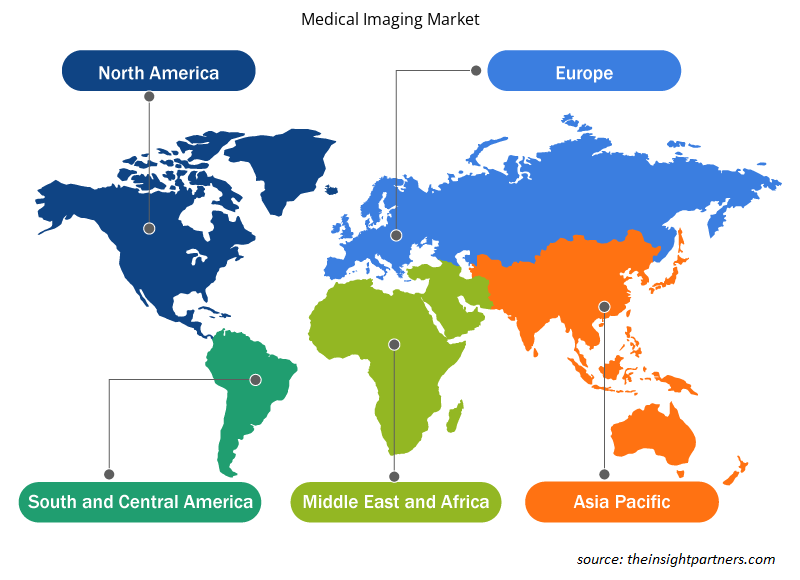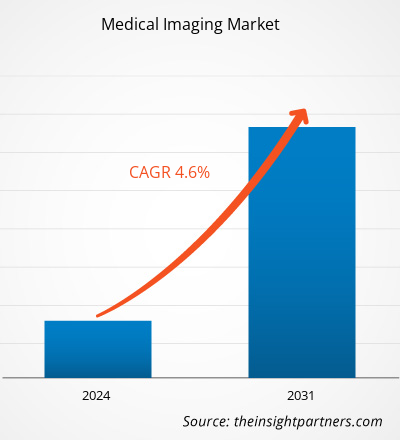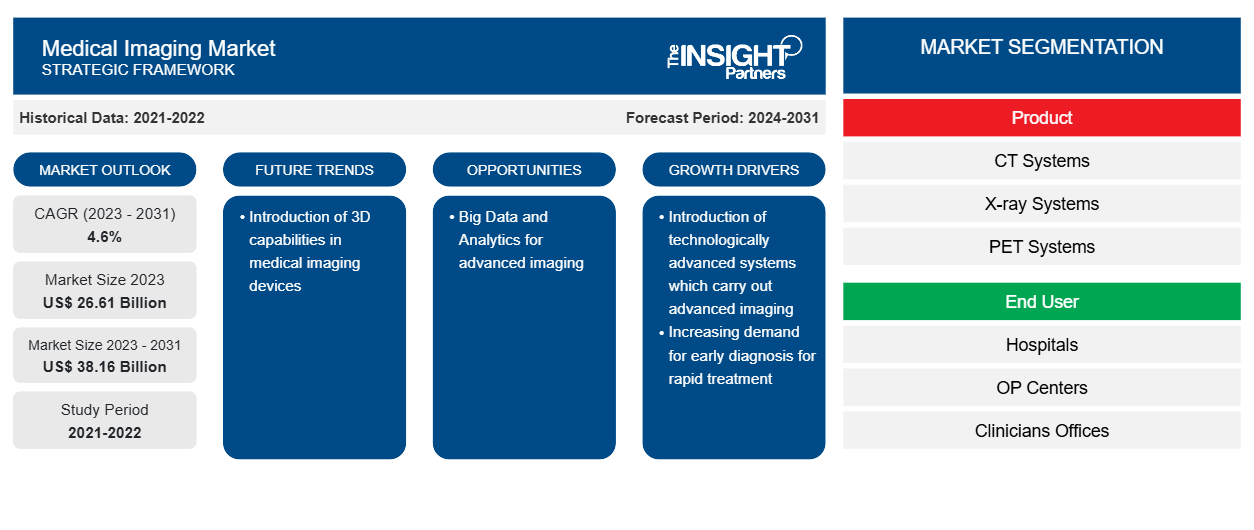Le marché de l'imagerie médicale devrait atteindre 38,16 milliards USD d'ici 2031, contre 26,61 milliards USD en 2023. Le marché devrait enregistrer un TCAC de 4,6 % au cours de la période 2023-2031. L'introduction de fonctionnalités 3D dans les appareils d'imagerie médicale devrait rester la tendance clé du marché.
Analyse du marché de l'imagerie médicale
La demande croissante de diagnostic précoce des maladies et l'élargissement du champ d'application clinique, la croissance rapide de la population gériatrique et l'augmentation subséquente de la prévalence des maladies associées , les avancées technologiques dans le secteur de l'imagerie diagnostique et l'augmentation des investissements, des fonds et des subventions des organismes publics-privés alimentent la croissance du marché de l'imagerie médicale. En outre, les initiatives gouvernementales visant à promouvoir l'imagerie médicale pour la prévention des maladies, l'augmentation des investissements dans les activités de R&D pour le développement d'imagerie médicale innovante et l'adoption croissante de l'imagerie médicale dans les pays en développement alimentent la croissance de la part de marché.
Aperçu du marché de l'imagerie médicale
Géographiquement, l'Asie-Pacifique devrait enregistrer le TCAC le plus élevé au cours de la période de prévision 2023-2031. L'attention croissante portée par les acteurs du marché à l'introduction d'imagerie médicale technologiquement développée pour diverses maladies alimente la croissance du marché. L'Inde se classe parmi les 20 premiers fabricants mondiaux de dispositifs médicaux et est le quatrième plus grand fabricant de dispositifs médicaux en Asie, suivi par le Japon, la Chine et la Corée du Sud. Le pays est susceptible de connaître une croissance potentielle grâce à sa base de population de plus d'un milliard d'habitants, à sa conscience sanitaire, à sa prospérité économique, à son expertise technologique, à l'enrichissement du personnel qualifié et au développement des installations de santé.
Personnalisez ce rapport en fonction de vos besoins
Vous bénéficierez d'une personnalisation gratuite de n'importe quel rapport, y compris de certaines parties de ce rapport, d'une analyse au niveau des pays, d'un pack de données Excel, ainsi que de superbes offres et réductions pour les start-ups et les universités.
-
Obtenez les principales tendances clés du marché de ce rapport.Cet échantillon GRATUIT comprendra une analyse de données, allant des tendances du marché aux estimations et prévisions.
Facteurs moteurs et opportunités du marché de l'imagerie médicale
La demande croissante de diagnostic précoce devrait favoriser le marché
Les tests diagnostiques sont un élément essentiel du système de santé, car ils fournissent des informations essentielles pour permettre aux prestataires et aux patients de prendre les bonnes décisions cliniques. Environ 75 % des décisions cliniques sont basées sur un test diagnostique. La demande d’accès à un diagnostic plus rapide et plus précis augmente de 10 % par an, ce qui accroît les coûts et met sous pression les capacités et les compétences des prestataires de diagnostic. Du point de vue du patient, une détection et un diagnostic précoces peuvent éviter des douleurs et des souffrances inutiles. Ils peuvent également réduire l’ampleur et le coût du traitement. De nombreuses recherches établissent un lien entre le diagnostic précoce et des avantages mesurables pour la santé, tels que des taux de survie améliorés et des coûts de traitement réduits. En outre, la sensibilisation du gouvernement stimulera davantage la croissance du marché. Par exemple, les campagnes Be Clear on Cancer visent à améliorer le diagnostic précoce du cancer en sensibilisant le public aux signes et symptômes du cancer et en encourageant les personnes à consulter leur médecin généraliste sans délai. Public Health England est responsable du programme, en collaboration avec le ministère de la Santé et le NHS England. Ainsi, une demande croissante de diagnostic précoce alimente la croissance du marché de l’imagerie médicale.
Le Big Data et l'analytique constituent une opportunité de croissance du marché
Selon un article sur ITN, Dhaval Shah et Prashanth Kollaikal de CitiusTech qui ont discuté du potentiel du big data dans l'imagerie diagnostique ont déclaré que de nouvelles fonctionnalités intéressantes dans le système d'information radiologique (RIS) et les systèmes PACS, en particulier ceux dans le cloud. Celles-ci peuvent également inclure des analyses et des rapports impressionnants sur les données opérationnelles et cliniques, comme indiqué dans l'article. Les indicateurs de performance clés (KPI) à l'échelle de l'entreprise sont dérivés de diverses sources. Ces KPI sont généralement utilisés pour répondre aux besoins du fournisseur et prendre en compte l'efficacité clinique et opérationnelle ainsi que le confort du patient. Bien que ces KPI soient utilisés à des fins d'optimisation depuis de nombreuses années, l'efficacité globale peut être facilement mesurée et peut être améliorée grâce à la maîtrise technologique des appareils, aux modalités accrues, aux systèmes logiciels avancés et aux appareils mobiles. Ainsi, l'accent croissant mis sur l'utilisation des données d'appel d'offres et des analyses dans l'imagerie médicale constitue une opportunité pour la croissance du marché de l'imagerie médicale.
Analyse de segmentation du rapport sur le marché de l'imagerie médicale
Les segments clés qui ont contribué à l’élaboration de l’analyse du marché de l’imagerie médicale sont le produit et l’utilisateur final.
- En fonction du produit, le marché de l'imagerie médicale est divisé en systèmes CT, systèmes à rayons X, systèmes PET, systèmes IRM, systèmes à ultrasons et autres. Le segment des systèmes à rayons X détenait la plus grande part de marché en 2023.
- En fonction de l'utilisateur final, le marché de l'imagerie médicale est divisé en hôpitaux, centres d'opération, cabinets de médecins et centres de soins d'urgence. Le segment des hôpitaux détenait la plus grande part de marché en 2023.
Analyse des parts de marché de l'imagerie médicale par géographie
La portée géographique du rapport sur le marché de l’imagerie médicale est principalement divisée en cinq régions : Amérique du Nord, Asie-Pacifique, Europe, Moyen-Orient et Afrique, et Amérique du Sud et centrale.
L'Amérique du Nord domine le marché. La croissance en Amérique du Nord est caractérisée par une augmentation de la demande d'imagerie médicale et de services des hôpitaux et des cliniques, un nombre croissant de patients subissant des procédures d'imagerie diagnostique, une forte sensibilisation des patients, un scénario de remboursement favorable et des dépenses de santé plus élevées. En outre, l'augmentation de la population gériatrique, le nombre croissant de maladies chroniques et le nombre croissant de centres de diagnostic et d'imagerie médicale dans les pays de la région sont susceptibles d'être à l'origine de la croissance du marché nord-américain de l'imagerie médicale au cours des années de prévision. Les États-Unis comptent de nombreuses cliniques de traitement chirurgical de pointe et un nombre croissant d'interventions chirurgicales orthopédiques. L'augmentation de la population gériatrique est l'un des facteurs de croissance du marché. L'augmentation de la population vieillissante reflète une augmentation du nombre de personnes subissant des traitements médicaux. La prévalence croissante du cancer devrait augmenter la demande d'appareils d'imagerie médicale aux États-Unis.
Aperçu régional du marché de l'imagerie médicale
Les tendances régionales et les facteurs influençant le marché de l’imagerie médicale tout au long de la période de prévision ont été expliqués en détail par les analystes d’Insight Partners. Cette section traite également des segments et de la géographie du marché de l’imagerie médicale en Amérique du Nord, en Europe, en Asie-Pacifique, au Moyen-Orient et en Afrique, ainsi qu’en Amérique du Sud et en Amérique centrale.

- Obtenez les données régionales spécifiques au marché de l'imagerie médicale
Portée du rapport sur le marché de l'imagerie médicale
| Attribut de rapport | Détails |
|---|---|
| Taille du marché en 2023 | 26,61 milliards de dollars américains |
| Taille du marché d'ici 2031 | 38,16 milliards de dollars américains |
| Taux de croissance annuel composé mondial (2023-2031) | 4,6% |
| Données historiques | 2021-2022 |
| Période de prévision | 2024-2031 |
| Segments couverts |
Par produit
|
| Régions et pays couverts |
Amérique du Nord
|
| Leaders du marché et profils d'entreprises clés |
|
Densité des acteurs du marché de l'imagerie médicale : comprendre son impact sur la dynamique commerciale
Le marché de l'imagerie médicale connaît une croissance rapide, tirée par la demande croissante des utilisateurs finaux en raison de facteurs tels que l'évolution des préférences des consommateurs, les avancées technologiques et une plus grande sensibilisation aux avantages du produit. À mesure que la demande augmente, les entreprises élargissent leurs offres, innovent pour répondre aux besoins des consommateurs et capitalisent sur les tendances émergentes, ce qui alimente davantage la croissance du marché.
La densité des acteurs du marché fait référence à la répartition des entreprises ou des sociétés opérant sur un marché ou un secteur particulier. Elle indique le nombre de concurrents (acteurs du marché) présents sur un marché donné par rapport à sa taille ou à sa valeur marchande totale.
Les principales entreprises opérant sur le marché de l'imagerie médicale sont :
- Compagnie Générale d'Électricité
- Siemens AG
- Royal Philips NV
- Société Shimadzu
- Hitachi, Ltée.
- Canon Inc.
Avis de non-responsabilité : les sociétés répertoriées ci-dessus ne sont pas classées dans un ordre particulier.

- Obtenez un aperçu des principaux acteurs du marché de l'imagerie médicale
Actualités et développements récents du marché de l'imagerie médicale
Le marché de l'imagerie médicale est évalué en collectant des données qualitatives et quantitatives après des recherches primaires et secondaires, qui comprennent des publications d'entreprise importantes, des données d'association et des bases de données. Quelques-uns des développements du marché de l'imagerie médicale sont énumérés ci-dessous :
- FUJIFILM India a élargi son portefeuille de produits et de solutions lors de la 75e Conférence nationale de l'Indian Radiological and Imaging Association (IRIA). Lancés à l'IRIA 2023, les Arietta 850 DeepInsight et Arietta 650 DeepInsight sont la dernière offre de technologie à ultrasons de FUJIFILM India. La nouvelle marque d'imagerie « DeepInsight » se compose de 5 éléments : précision, reproductibilité, visibilité, efficacité et utilisation de l'IA. (Source : Fujifilm, site Web de l'entreprise, février 2023)
- FUJIFILM Healthcare Americas Corporation a reçu l'autorisation 510(k) de la FDA pour son nouveau système d'imagerie par résonance magnétique (IRM) de 1,5 Tesla, l'ECHELON Synergy. Le système utilise Synergy DLR, la technologie exclusive de reconstruction par apprentissage profond (DLR) de Fujifilm alimentée par l'intelligence artificielle (IA), pour améliorer la netteté des images et acquérir des scans plus rapidement, contribuant ainsi à un débit, une qualité d'image et une satisfaction des patients plus élevés. (Source : Fujifilm, site Web de l'entreprise, août 2023)
Rapport sur le marché de l'imagerie médicale : couverture et livrables
Le rapport « Taille et prévisions du marché de l’imagerie médicale (2021-2031) » fournit une analyse détaillée du marché couvrant les domaines ci-dessous :
- Taille et prévisions du marché des kits de tests rapides aux niveaux mondial, régional et national pour tous les segments de marché clés couverts par le champ d'application
- Tendances du marché des kits de tests rapides ainsi que la dynamique du marché telles que les facteurs moteurs, les contraintes et les opportunités clés
- Analyse détaillée des cinq forces de PEST/Porter et SWOT
- Analyse du marché des kits de tests rapides couvrant les principales tendances du marché, le cadre mondial et régional, les principaux acteurs, les réglementations et les développements récents du marché
- Analyse du paysage industriel et de la concurrence couvrant la concentration du marché, l'analyse de la carte thermique, les principaux acteurs et les développements récents du marché de l'imagerie médicale
- Profils d'entreprise détaillés
- Analyse historique (2 ans), année de base, prévision (7 ans) avec TCAC
- Analyse PEST et SWOT
- Taille du marché Valeur / Volume - Mondial, Régional, Pays
- Industrie et paysage concurrentiel
- Ensemble de données Excel
Rapports récents
Rapports connexes
Témoignages
Raison d'acheter
- Prise de décision éclairée
- Compréhension de la dynamique du marché
- Analyse concurrentielle
- Connaissances clients
- Prévisions de marché
- Atténuation des risques
- Planification stratégique
- Justification des investissements
- Identification des marchés émergents
- Amélioration des stratégies marketing
- Amélioration de l'efficacité opérationnelle
- Alignement sur les tendances réglementaires























 Obtenez un échantillon gratuit pour - Marché de l'imagerie médicale
Obtenez un échantillon gratuit pour - Marché de l'imagerie médicale